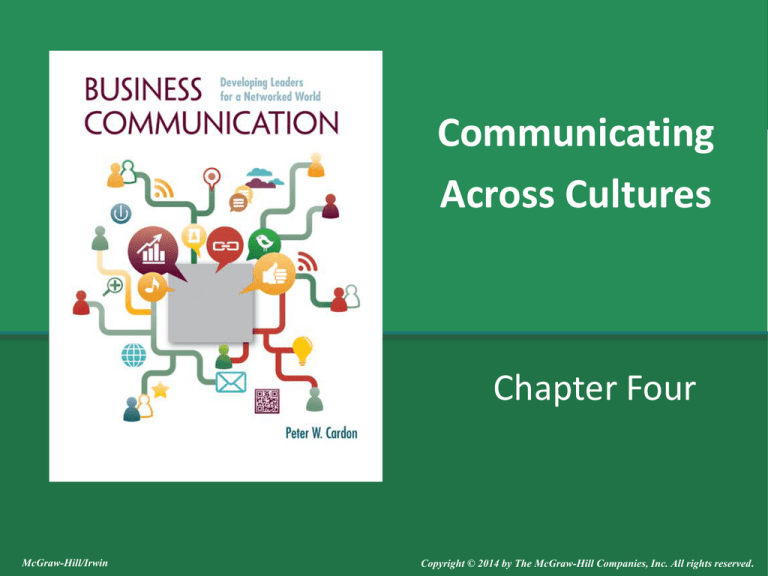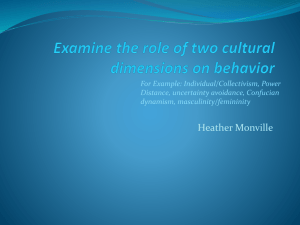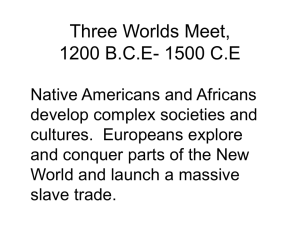
Communicating
Across Cultures
Chapter Four
McGraw-Hill/Irwin
Copyright © 2014 by The McGraw-Hill Companies, Inc. All rights reserved.
Learning Objectives
LO4.1 Describe characteristics of cultural
intelligence, its importance for global
business leaders, and approaches to
developing it.
LO4.2 Explain the major cultural dimensions and
related communication practices.
LO4.3 Name and describe key categories of
business etiquette in the intercultural
communication process.
4-2
Developing Cultural Intelligence
Cultural intelligence
(CQ)
a measure of your
ability to work with
and adapt to
members of other
cultures.
4-3
Developing Cultural Intelligence
Culture
includes the shared values, norms, rules, and
behaviors of an identifiable group of people who
share a common history and communication
system.
national, organizational, team
4-4
Cultural Intelligence in the
Workplace
Table 4.2
4-5
Respect, Recognize, and Appreciate
Cultural Differences
Cultural intelligence is built on viewing other
cultures as holding legitimate and valid views
of and approaches to managing business and
workplace relationships
4-6
Be Curious about Other Cultures
Study abroad
Learn a language
Develop friendships with international
students on your campus
Take an interest in culture and routinely learn
about it
4-7
Take an Interest in a Culture and
Routinely Learn About It
Watch films, television, documentaries, news,
and other video of the culture
Follow the business culture of a country
Take courses and attend events related to
particular cultures
Make friends with people who live in other
cultures and communicate online
4-8
Avoid Inappropriate Stereotypes
Projected cognitive
similarity
the tendency to
assume others have
the same norms and
values as your own
cultural group.
Outgroup
homogeneity effect
the tendency to think
members of other
groups are all the
same.
4-9
Perceptions that Members of Various
Cultures Have about Americans
Table 4.3
4-10
Adjust Your Conceptions of Time
People high in CQ show patience
They understand that most tasks take longer
when working across cultures because more
time is needed to understand one another
and cooperate effectively
4-11
Manage Language Differences
Avoid quickly judging that others have limited
communication proficiency
Articulate clearly and slow down
Avoid slang and jargon
Give others time to express themselves
Use interpreters as necessary
4-12
Understanding Cultural Dimensions
Cultural dimensions
fairly permanent and
enduring sets of
related norms and
values
4-13
Understanding Cultural Dimensions
Individualism
and
collectivism
Egalitarianism
and hierarchy,
Assertiveness
Performance
orientation
Future
orientation
Humane
orientation
Uncertainty
avoidance
Gender
egalitarianism
4-14
Individualism and Collectivism
Individualism
Figure 4.2
a mind-set that prioritizes
independence more highly than
interdependence, emphasizing
individual goals over group goals,
and valuing choice more than
obligation
4-15
Individualism and Collectivism
Figure 4.3
Collectivism
a mind-set that prioritizes
interdependence more highly than
independence, emphasizing group
goals over individual goals, and
valuing obligation more than choice
4-16
Communication Practices in High
Individualist and High Collectivist Cultures
Table 4.4
4-17
Egalitarianism and Hierarchy
Egalitarian cultures
People tend to distribute and share power evenly,
minimize status differences, and minimize special
privileges and opportunities for people just
because they have
higher authority
4-18
Egalitarianism and Hierarchy
Figure 4.5
Hierarchical cultures
people expect power
differences, follow leaders
without questioning them, and
feel comfortable with leaders
receiving special privileges and
opportunities
4-19
Communication Practices in Egalitarian
and Hierarchical Cultures
Table 4.5
4-20
Performance Orientation
Performance orientation (PO)
Figure 4.6
the extent to which a
community encourages and
rewards innovation, high
standards, and performance
improvement
4-21
Communication in High Performance
and Low Performance Societies
Table 4.6
4-22
Future Orientation
Future orientation (FO)
Figure 4.7
involves the degree to which
cultures are willing to sacrifice
current wants to achieve
future needs.
4-23
Communication Practices in High and
Low Future Orientation Cultures
Table 4.7
4-24
Assertiveness
Assertiveness
Figure 4.8
deals with the level of confrontation
and directness that is considered
appropriate and productive
4-25
Communication Practices in High
and Low Assertiveness Cultures
Table 4.8
4-26
Humane Orientation
Figure 4.9
Humane orientation (HO)
the degree to which an
organization or society encourages
and rewards individuals for being
fair, altruistic, friendly, generous,
caring, and kind
4-27
Communication Styles in High and
Low Humane Orientation Cultures
Table 4.9
4-28
Uncertainty Avoidance
Uncertainty avoidance (UA)
Figure 4.10
refers to how cultures socialize
members to feel in uncertain, novel,
surprising, or extraordinary
situations.
4-29
Communication Styles in High and Low
Uncertainty Avoidance Cultures
Table 4.10
4-30
Gender Egalitarianism
Gender
egalitarianism
deals with the
division of roles
between men and
women in society
4-31
Communication Practices in High and
Low Gender-Egalitarianism Cultures
Table 4.11
4-32
Building and Maintaining CrossCultural Work Relationships
Establish Trust and Show Empathy
Adopt a Learner Mind-set
Build a Co-Culture of Cooperation and
Innovation
4-33
Etiquette and Customs in the
BRIC Countries
Table 4.13
4-34












